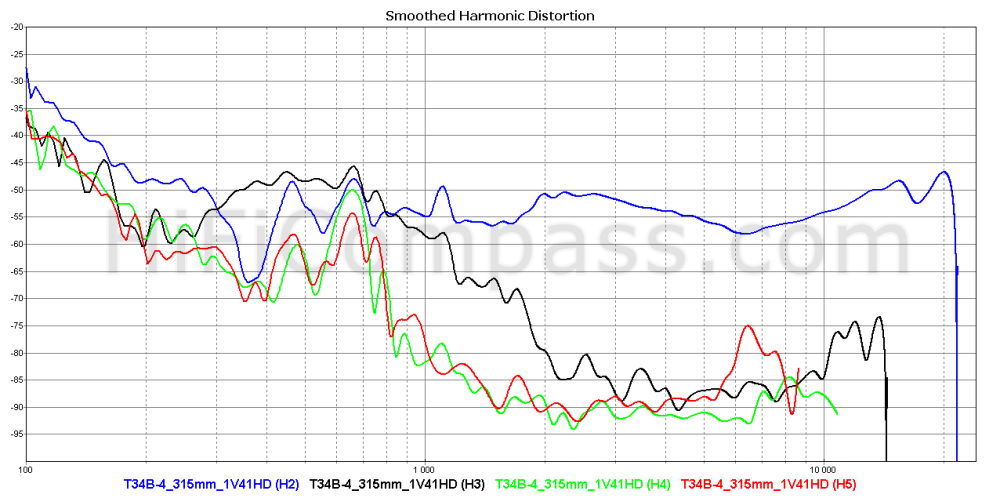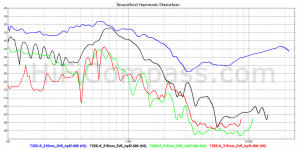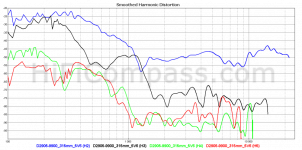The measurements of the Viawave ribbon tweeter have been added:
Viawave SRT-7 | HiFiCompass
The review is coming...
Jesús María what a tweeter 🙂
Last edited:
Just be sure to read the "Features/Comments" section to see what filters were in place for the distortion measurements. It can be a bit misleading because it appears (to me) that the filters were not in place for the frequency response measurements. So there isn't a one to one match between the frequency response and distortion measurements.
I've read it, of course. 2kHz and up (24dB/o filter in place) it measures great. I wouldn't use it under 2kHz in the first place.
Jesús María what a tweeter 🙂

I thought it was the GRT-145 at first..
Still, as I mentioned here with respect to the GRT-145:
Some speaker driver measurements...
Basically get that right (waveguide) for the SRT-7, get production costs pretty low, and sell the crap out of them to the pro market - which is a MUCH larger market. A lot of compression drivers would be left sitting on the shelves with that solution.
I would say that SRT-7 is an improved version of the GRT-145. Just improving the tweeter did not affect the price. In the GRT-145W and SRT-7, the rear chamber is sectioned. Sectioning is used to reduce distortion near the resonance frequency of the chamber. In the GRT-145, foam rubber is used in the rear chamber, which is also necessary to reduce distortion near the resonance frequency of the rear chamber. But foam also affects the FR in the working range. Therefore, the GRT-145, it has a boost at high frequencies. I would say that the gross setup of the rear chamber was applied in the GRT-145. In the SRT-7, the setup of the rear chamber is made more accurately. - Dimitry
I'm not familiar with TL products, so can't comment here. As for Be tweeters - I would advise take a look at the BlieSMa T25B-6.
I think these were originally targeted for a November release. Do you have any additional information on when the T25 line will be available?
I think these were originally targeted for a November release. Do you have any additional information on when the T25 line will be available?
I'm waiting for them for a project too🙂 I was said in December-January.
The measurements of the BlieSMa T25D-6 Diamond dome tweeter have been added:
BlieSMa T25D-6 | HiFiCompass
BlieSMa T25D-6 | HiFiCompass
Are you doing listening sessions to the tweeters as well or only measurements ?The measurements of the BlieSMa T25D-6 Diamond dome tweeter have been added:
BlieSMa T25D-6 | HiFiCompass
Both T25B and T25D have splendid behavior, but I think the T25B is the overall winner in this battle. CSD measures a tad better for the T25B as well.
Usually, I prefer don't share my subjective impression. But I can say certainly that Al, Be, and D versions sound quite different and it is very good can be heard.Are you doing listening sessions to the tweeters as well or only measurements ?
Both T25B and T25D have splendid behavior, but I think the T25B is the overall winner in this battle. CSD measures a tad better for the T25B as well.
Indulge me, I am not going to judge you. I would very much like to hear your subjective findings between the Al/Be/D versions. What is the unique characteristics you found ?Usually, I prefer don't share my subjective impression. But I can say certainly that Al, Be, and D versions sound quite different and it is very good can be heard.
Take the Accuton diamond vs Bowers&Wilkins diamond, very different beasts. The Accuton is forward and bright while B&W is laid back and relaxed.
Okay, will try to translate my listening impressions to letters on the next week🙂Indulge me, I am not going to judge you. I would very much like to hear your subjective findings between the Al/Be/D versions. What is the unique characteristics you found ?
Take the Accuton diamond vs Bowers&Wilkins diamond, very different beasts. The Accuton is forward and bright while B&W is laid back and relaxed.
The measurements of the BlieSMa T25D-6 Diamond dome tweeter have been added:
BlieSMa T25D-6 | HiFiCompass
Obviously, not much has changed in 30 years of happy development ... at least THD-wise. Why that ???
BliesMa Beryllium vs. Scan-Speak D2509 99000
Attachments
That might be, but if nothing els, you are doing clever marketing.. 🙂. Looking at the frequency response, then things change. While harmonic content can be said to have matured years ago, the on- and off axis most certainly needed an update, and that is what we are getting with some of the newer tweeters.Obviously, not much has changed in 30 years of happy development ... at least THD-wise. Why that ???
BliesMa Beryllium vs. Scan-Speak D2509 99000
Maybe I might be clever, thanks for that one, and you might be right in this term, maybe. But I don't intend to do any marketing at all. Here you are definitively wrong. I am simply comparing different drivers. And also I would most be interested in having the opportunity to compare multitone IM measurements, also.That might be, but if nothing els, you are doing clever marketing.. 🙂. Looking at the frequency response, then things change. While harmonic content can be said to have matured years ago, the on- and off axis most certainly needed an update, and that is what we are getting with some of the newer tweeters.
The brand nes Bliesma is certainly a nice driver and better than most other tweeters, but not overwhelmingly better. It's not a magnitude better in all terms, but slightly better in some terms compared e.g. to the (old man) SS:
Comparing both speakers in terms of frequency response, Bliesma is indeed smoother and extends this way from 1.2kHz to some 32kHz within +-2dB. This is really nice. Scan-Speak is slightly more irregular and within +-2B from 950Hz to 20kHz. +1 for Bliesma.
Comparing both speakers in terms of CD, again Bliesma is the winner.
But still, in the range around 2kHz, ScanSpeak is the clear winner (<50dB/0.31% for SS vs. <40dB/1% for BliesMa @ 5.6V input). And this is puzzling. After all these years of development, CAD and new materials, I am really disappointed that no driver is on market with less than 0.1% THD @ 96dB/1m troughout 1.5kHz to > 20kHz. Should be possible, though.
No marketing at all, then. Just comparing and hoping for the really, substantially better to come, yet.
And please include multitone IM measurements.
Harmonics
Hope that helps.H2 and H3 distortion behavior is quite similar to T34. Of course, if you’ll compare these 2 drivers with the same SPL, T25’s H2 will be higher because 2 times more excursion required for the same SPL and H3 will be also higher just because of lower efficiency. It’s just linear mechanics, you can’t do nothing about that. Anyway, T25 distortion will be lower than Accuton’s Cell C25-6-158, if it can be helpful to you to judge. I hope very soon we’ll send some of the driver for the official tests. - Stanislav Malikov, Bliesma

@Daihedz:
It's not puzzling at all. You are comparing a waveguided tweeter with regular one. Bliesma is smaller so CTC distance will be smaller also, unlike SS. Put Bliesma in a shallow waveguide and compare it then.
You're right about one thing though, performance is just a bit better. Dome tweeters are hitting the limits of what is possible with todays materials and software.
I think that biggest advances are being made in planar tweeters (amt and ribbon in particular). Viavawe ribbon tweeters are remarcable. Also, HEDD/ADAM type AMT and Mundorf AMT measure great. Now, smallest Mundorf has around 24cm^2 surface, equivalent to 2" dome and it has great horizontal directivity. Subjective difference between 8cm^2 (regular 1" dome tweeter) and 24cm^2 ( 1" wide amt) playing the same tone is phenomenal.
It's not puzzling at all. You are comparing a waveguided tweeter with regular one. Bliesma is smaller so CTC distance will be smaller also, unlike SS. Put Bliesma in a shallow waveguide and compare it then.
You're right about one thing though, performance is just a bit better. Dome tweeters are hitting the limits of what is possible with todays materials and software.
I think that biggest advances are being made in planar tweeters (amt and ribbon in particular). Viavawe ribbon tweeters are remarcable. Also, HEDD/ADAM type AMT and Mundorf AMT measure great. Now, smallest Mundorf has around 24cm^2 surface, equivalent to 2" dome and it has great horizontal directivity. Subjective difference between 8cm^2 (regular 1" dome tweeter) and 24cm^2 ( 1" wide amt) playing the same tone is phenomenal.
Last edited:
The measurements of the BlieSMa T25D-6 Diamond dome tweeter have been added:
BlieSMa T25D-6 | HiFiCompass
I'm guessing this is more expensive.. a LOT more.
-and considering the performance, it will quite literally be:
..a HARD sell. 😛
- Home
- Loudspeakers
- Multi-Way
- Some speaker driver measurements...

